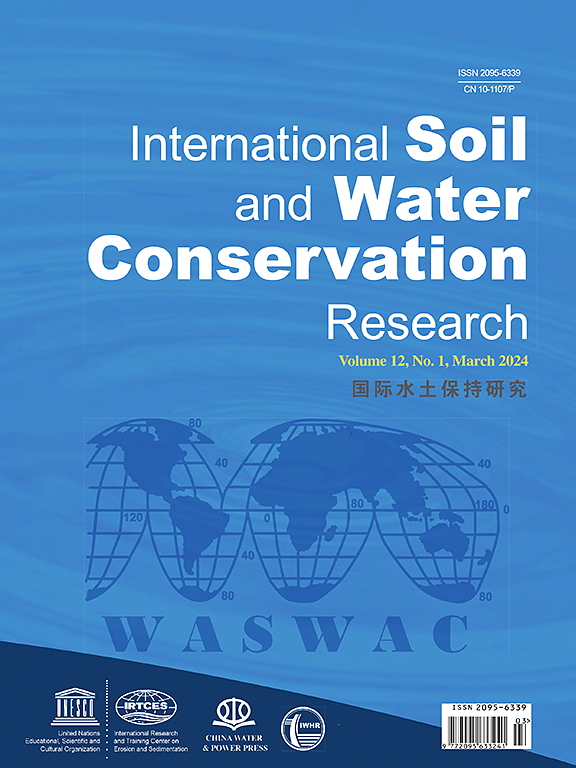Exploring best soil conservation practices using the tolerable soil loss limit in central highland of Ethiopia: A case study of Andit Tid watershed
IF 7.3
1区 农林科学
Q1 ENVIRONMENTAL SCIENCES
International Soil and Water Conservation Research
Pub Date : 2025-01-04
DOI:10.1016/j.iswcr.2025.01.001
引用次数: 0
Abstract
Soil erosion is a major issue in Ethiopia, prompting ongoing watershed development campaigns. This study contributes to exploring Best Soil Conservation practices (BSCPs) to reduce erosion rates to/or below Tolerable Soil Loss Limits (TSLLs). To achieve these the study used the SWAT model, coupled with the SWAT Calibration and Uncertainty Procedures (SWAT-CUP), for simulation, sensitivity analysis, calibration, and validation using streamflow and sediment yield data. The calibrated SWAT model was used to assess soil erosion hotspot areas and evaluate the effectiveness of the selected BSCPs: Soil and/or Stone Bund (SSB), Grass strip (GT), reforestation (RF), Soil and/or Stone Bund and grass strip (SSB and GT) and Soil and/or Stone Bund and Reforestation (SSB and RF). The results revealed that 22.9% of the area showed soil loss rates below the TSLL. Furthermore, varying degrees of erosion above the TSLL was observed, with sub-watershed SW-12 experiencing the highest erosion rate (47 t ha−1yr−1) and sub-watershed SW-2 experiencing the lowest (7.8 t ha−1yr−1). Among the evaluated BSCPs, SSB + RF demonstrated the greatest erosion reduction effectiveness at 76.6%, followed by SSB + GT, SSB, RF, and GT, with erosion reduction effectiveness values of 61.7%, 60.0%, 43.3%, and 13.9%, respectively. Based on these findings, SSB + RF is recommended for erosion reduction to or below the TSLL, with implementation priority given to sub-watersheds SW-12, SW-10, SW-3, SW-2, and SW-5, ranked in descending order of erosion rate severity. During implementation, emphasis should be placed on reforestation of plant species of high ecological importance.
利用埃塞俄比亚中部高地可容忍土壤流失极限探索最佳土壤保持措施:以Andit Tid流域为例
土壤侵蚀是埃塞俄比亚的一个主要问题,促使正在进行的流域发展运动。该研究有助于探索最佳土壤保持措施(BSCPs),以将侵蚀率降低到/或低于可容忍土壤流失极限(TSLLs)。为了实现这些目标,该研究使用SWAT模型,结合SWAT校准和不确定度程序(SWAT- cup),利用河流和泥沙产量数据进行模拟、灵敏度分析、校准和验证。利用校正后的SWAT模型对土壤侵蚀热点地区进行评估,并对选定的BSCPs:土壤和/或石滩(SSB)、草带(GT)、再造林(RF)、土壤和/或石滩和草带(SSB和GT)和土壤和/或石滩和再造林(SSB和RF)的有效性进行评估。结果表明,22.9%的区域土壤流失率低于土壤流失率界线。此外,TSLL以上的侵蚀程度也不同,其中小流域SW-12的侵蚀速率最高(47 t ha - 1yr -1),小流域SW-2的侵蚀速率最低(7.8 t ha - 1yr -1)。其中,SSB + RF的减蚀效果最好,为76.6%,其次是SSB + GT、SSB、RF和GT,减蚀效果分别为61.7%、60.0%、43.3%和13.9%。基于这些发现,建议将SSB + RF减少到或低于TSLL,并优先实施SW-12, SW-10, SW-3, SW-2和SW-5子流域,侵蚀速率严重程度由高到低。在实施过程中,重点应放在对生态有重要意义的植物物种的重新造林上。
本文章由计算机程序翻译,如有差异,请以英文原文为准。
求助全文
约1分钟内获得全文
求助全文
来源期刊

International Soil and Water Conservation Research
Agricultural and Biological Sciences-Agronomy and Crop Science
CiteScore
12.00
自引率
3.10%
发文量
171
审稿时长
49 days
期刊介绍:
The International Soil and Water Conservation Research (ISWCR), the official journal of World Association of Soil and Water Conservation (WASWAC) http://www.waswac.org, is a multidisciplinary journal of soil and water conservation research, practice, policy, and perspectives. It aims to disseminate new knowledge and promote the practice of soil and water conservation.
The scope of International Soil and Water Conservation Research includes research, strategies, and technologies for prediction, prevention, and protection of soil and water resources. It deals with identification, characterization, and modeling; dynamic monitoring and evaluation; assessment and management of conservation practice and creation and implementation of quality standards.
Examples of appropriate topical areas include (but are not limited to):
• Conservation models, tools, and technologies
• Conservation agricultural
• Soil health resources, indicators, assessment, and management
• Land degradation
• Sustainable development
• Soil erosion and its control
• Soil erosion processes
• Water resources assessment and management
• Watershed management
• Soil erosion models
• Literature review on topics related soil and water conservation research
 求助内容:
求助内容: 应助结果提醒方式:
应助结果提醒方式:


